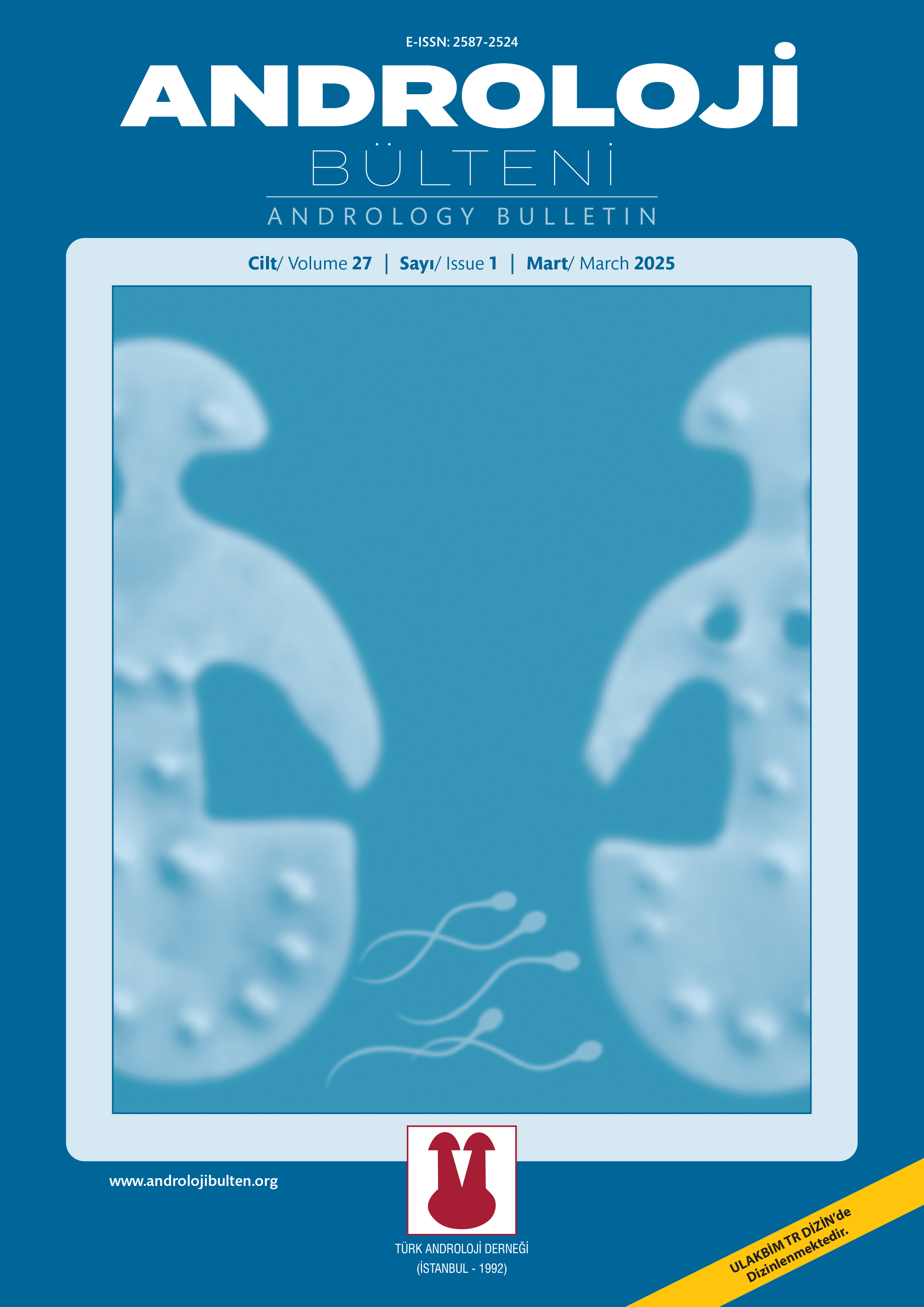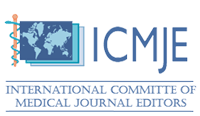INDEXES

Content of this journal is licensed under a Creative Commons Attribution-NonCommercial 4.0 International License.
Volume: 24 Issue: 3 - 2022
| 1. | Cover Page I |
| 2. | Reviewers Pages II - III |
| 3. | From the President Page IV |
| 4. | From the Editor Page V |
| 5. | Contents Page VI |
| ORIGINAL ARTICLE | |
| 6. | The percentages of usage of phosphodiesterase 5 inhibitors for the first-line treatment in patients with erectile dysfunction Adem Sancı, Cihat Özcan doi: 10.24898/tandro.2022.78095 Pages 167 - 171 OBJECTIVE: We aimed to investigate the rate of use of phosphodiesterase 5 (PDE5) inhibitors drugs recommended for patients with erectile dysfunction (ED). MATRERIAL and METHODS: Patients who applied to the urology outpatient clinic for the first time due to ED between February 2021 and February 2022 and were recommended PDE5 inhibitors as firstline therapy were included in the study. Patients requiring a specific diagnostic test, patients requiring psychosocial examination, patients with an underlying endocrinological disease that needed to be corrected after laboratory examinations, and patients included in the high-risk group in cardiac risk classification were excluded from the study. The telephone number of each patient was added to the outpatient evaluation note. The patients were followed up at 1 month. 1st month follow-ups were carried out face-to-face if the patient came for control, or by phone numbers if he did not. RESULTS: Of the 624 patients admitted for the first time with ED, 405 patients who were started on PDE5 inhibitors as first-line therapy were included in the study. It was determined that 147 (36.2%) of the 405 patients who were recommended to use PDE5 inhibitors as first-line treatment were taking the prescribed drug or its appropriate equivalent. It was observed that 74 (18.2%) patients bought counterfeit drugs from companies that were contacted through various websites and television channels. It was determined that 31 (7.6%) patients used herbal products containing gingko biloba and ginseng. CONCLUSION: It should be well known by urology physicians that the inability to take 5 PDE inhibitor drugs, which leads to the use of counterfeit drugs and herbal drugs, may result in unresponsiveness to drug treatment and unnecessary costs. In the future, using these drugs in certain indications and with reports approved by certain committees and including them in the scope of reimbursement will make serious contributions to the patients and the country’s economy. |
| 7. | Adaptation of the premarital risky sexual behavior assessment scale for young women into Turkish: Validity and reliability study Meltem Mecdi Kaydırak, Fatma Aslan Demirtaş, Ümran Oskay, Azam Rahmani doi: 10.24898/tandro.2022.64426 Pages 172 - 179 OBJECTIVE: In the study, it was aimed to adapt the Premarital Risky Sexual Behavior Scale for Young Women (PRSAS-YW) into Turkish and to investigate the validity and reliability of the Turkish version. MATRERIAL and METHODS: This research is a methodological study and it was conducted with 212 young women who were studying at the Faculty of Nursing, Science-Literature and Education of Istanbul University-Cerrahpaşa and who met the research criteria. “Participant Information Form” and “PRSAS-YW” were used to collect the data. For construct validity, “Explanatory Factor Analysis” and “Confirmatory Factor Analysis” were performed. P≤0.05 was taken as statistical significance value. The reliability study was evaluated by item-total correlation, Cronbach’s α coefficients, and test-retest. RESULTS: The data were evaluated in terms of inter-expert agreement for content validity after language adaptation and content validity assessment. A total of 6 items were removed from the scale. The content validity rate of the study was determined as 0.98. After the application, 3 items with item total score correlation values below 0.30 and 3 overlapping items were removed from the scale. The remaining items from the scale were grouped under 3 factors. As a result of the analysis made with the remaining 20 items and 3 sub-dimensions, it was determined that the AGFI and GFI goodness of fit indices were at a sufficient level. In the reliability analysis, the Cronbach α coefficient was 0.897 and the test-retest correlation coefficient was r=0.990. CONCLUSION: As a result of the research, it was determined that the form of the scale consisting of 20 items and 3 sub-dimensions is valid and reliable and can be used to evaluate risky sexual behaviors of young women. |
| 8. | Evaluation of testicular shear wave elastography in men with idiopathic oligoastenospermia; Prospective, controlled study Mustafa Gök, Hakan Görkem Kazıcı, Göksel Tuzcu, Gökhan Şahin, Arif Kol, Erhan Ateş doi: 10.24898/tandro.2022.56588 Pages 180 - 185 OBJECTIVE: To compare shear wave elastographic (SWE) measurements on testicular ultrasonography of idiopathic oligoasthenospermic infertile men, against fertile men with normal semen parameters and to evaluate the relationship between testicular SWE values and semen parameters. MATRERIAL and METHODS: Of the 63 men included in the study, 28 men formed the idiopathic oligoasthenospermic group (Group 1) and 35 men with normal semen parameters were within the control group (Group 2). Age, total sperm count, sperm concentration, total motile sperm count, mean testicular volume and mean testicular SWE values of both groups were recorded and compared. In addition, the correlation of testicular SWE values of all participants with semen parameters and testicular volume was analyzed using appropriate statistical methods. RESULTS: There was no significant difference between the groups in terms of mean age and testicular volume (p>0.05). The mean testicular SWE values were statistically different between Group 1 and Group 2 (2.39±0.05 vs 2.69±0.11, p=0.015) with a positive correlation found between total sperm count, sperm concentration, total motile sperm count and testicular SWE values (p=0.03, p=0.03 and p=0.015, respectively). CONCLUSION: Shear wave elastography is an inexpensive and effective method in distinguishing idiopathic oligoasthenospermic cases from cases with normal semen parameters. The improvement in semen parameters is positively correlated with increases in testicular SWE values, with this correlation being stronger than other parameters in terms of motile sperm count. Our study shows that the use of SWE in the diagnosis of infertility can provide complementary information to semen analysis. |
| 9. | Evaluation of the quality and reliability of YouTube video resources on microdissection testicular sperm extraction Adem Sancı, Cihat Özcan doi: 10.24898/tandro.2022.60863 Pages 186 - 190 OBJECTIVE: In this study, our aim is to evaluate the quality and reliability of Turkish videos associated with mTESE on YouTube. MATRERIAL and METHODS: YouTube’s search function was used to find videos associated with mTESE. On April 1, 2022, systematic research was performed using the term “micro TESE”, covering the last 5 years in order to be up to date. The first 50 videos were included in the study. The quality of the videos was evaluated using the Global Quality Score (GQS). The modified DISCERN scale was used to evaluate the reliability of the videos. RESULTS: A total of 50 videos associated with mTESE were analyzed. All videos were prepared by a urologist who deals with infertility. 46% of the medical doctors had academic titles. The most frequently discussed topics in the videos were operation time (32%), success rates of the mTESE procedure (58%), factors that increase the success of the mTESE procedure (52%), and postoperative complications (26%). The mean GQS of the videos was 3.16±0.86. When the reliability of the sources was evaluated using the DISCERN score, the mean score of the videos was 2.19±1.4. There were no full-rated videos from DISCERN. There was no correlation between the GQS and DISCERN evaluation score and other characteristic variables of the videos. CONCLUSION: The present study shows that the level of knowledge in Turkish sources on YouTube associated with micro TESE is at an acceptable level, but its scientific reliability is low. Therefore, short and concise videos that contain accurate and up-to-date information and refer to scientific facts in plain language should be prepared by the relevant associations. |
| 10. | The impact of COVID-19 infection on sexual functions of males and associated risk factors Emre Salabas, Hüseyin Cihan Demirel, Semih Türk, İbrahim Halil Baloğlu doi: 10.24898/tandro.2022.57984 Pages 191 - 198 OBJECTIVE: The objective of this study is to investigate the sexual dysfunction(SD) occurring after COVID-19 disease and possible risk factors. MATRERIAL and METHODS: This is the first longitudinal study comparing the sexual health of males, prior and latter to PCR confirmed COVID-19 diagnosis using the all domains of International index of erectile function-15 (IIEF-15) questionnaire and investigating the risk factors for SD. Between 2020-2021, 114 male patients were included and surveyed by IIEF-15 twice, at the time of diagnosis and after 3 months. RESULTS: Median age was 49 years (IQR: 29-58.5). Median IIEF-EF score decreased (24 to 20,p=0.001) and there was also a statistically significant decline in all domains of IIEF-15 including orgasm (9 to 8,p=0.01), sexual desire (8 to 7,p=0.001), sexual satisfaction (11 to 8,p=0.001) and over satisfaction (8 to 7,p=0.001). Patients with an IIEF-EF decrease > 4 (n=27, 23.7%) had significantly higher rates of diabetes (37% vs 13.8%, p=0.01), hypertension (40.7% vs 20.7%, p=0.04), smoking (40.7% vs 20.7%, p=0.04), COVID-19 pneumonia (44.4% vs 23.0%, p=0.03) and lower rates of fatigue (66.7% vs 86.2%, p=0.02) than the other group Pneumonia (OR: 3.55,p=0.02), and fatigue (OR: 0.22,p=0.01) were significant independent risk factors of minimally clinically significant IIEF-EF decrease (>4). CONCLUSION: COVID-19 cases may present with urologic symptoms to our outpatient clinics. The disease causes deterioration in all aspects of sexual function, including erectile function, orgasm, sexual desire and satisfaction of the patients. A third of patients face a decrease of one rank in erectile dysfunction severity. Pneumonia and fatigue symptoms are significant risk factors of post-COVID-19 erectile dysfunction. Pneumonia, urinary urgency symptom and diabetes mellitus increase the risk of deterioration in IIEF domains besides erectile function. Endothelial dysfunction may be one of the causes of post COVID-19 sexual function decline.. |
| REVIEW | |
| 11. | Sexual life and nursing approach in obesity Ebru Cirban Ekrem, Melike Kahveci, Özlem Demirel Bozkurt doi: 10.24898/tandro.2022.84755 Pages 199 - 203 Sexuality is an action that has an important role in people’s lives physiologically, biologically and psychologically, and sexuality is affected by many factors in human life. Obesity is a global health problem with an increasing incidence in the world. Obesity affects sexuality in men and women with various pathophysiological mechanisms, in different shapes and sizes. Diagnosis and treatment of existing risk factors and comorbidities in individuals is a decisive factor in improving quality of life and preventing sexual dysfunction in people with obesity. It should not be ignored that the biopsychosocial health of the individual will also be positively affected when a problem related to sexual life is resolved. In terms of sexual counselling for obese individuals, nurses should emphasize the quality of life of individuals and the factors that increase the quality of sexual life. While giving counselling to obese individuals about sexual life, nurses should choose the models that are suitable for the individual. In this review, it was aimed to examine the effects of male and female obesity on sexual health and sexual life, obesity-related comorbidities, sexual functionality and nursing approach in obesity in line with the literature. |
| 12. | Violence against women, sexual violence and nurses responsibilities Esra Güler, Nülüfer Erbil doi: 10.24898/tandro.2022.38159 Pages 204 - 213 Violence against women is a worldwide public health problem that has existed in all ages of humanity, from past to present, with significant differences both between and within countries. Local and global factors such as ensuring the continuity of patriarchal culture, traditional gender roles, gender inequality, lack of laws and policies, and the COVID-19 process have caused the continuity of violence against women. Violence manifests itself as physical, sexual, economic, psychological and cyber bullying in the life stages of women. Violence experienced within the family, which is the basis of society, sometimes directly or indirectly affects the child raised by the woman who is exposed to violence, and therefore also the future of the society. It is possible to see the traces of violence and its negative effects on health in every period of life of women who are exposed to violence. For this, it is recommended to be aware of domestic violence, to introduce the resources to help and support women in the experience of violence, and to increase the effectiveness of laws and action plans. Nurses are health professionals who have a key role in which women who are isolated from the society and who have been subjected to violence can establish relationships and interact outside their homes. Nurses should take a role in identifying women victims of violence, supporting and caring for women in the risk group, and developing effective intervention programs to prevent problems and multiple victimization. |
| 13. | Current practices in the management of vulvovagınal atrophy in postmenoposal perıod Nurgül Şimal Yavuz, Nebahat Özerdoğan doi: 10.24898/tandro.2022.35651 Pages 214 - 220 Vulvovaginal atrophy (VVA) is the result of thinning of mucus and tissues in the vulva and vagina caused by estrogen deprivation that occurs in menopausal women. Estrogen stimulation in the female body is responsible for maintaining the normal anatomy and physiology of the urogenital system. As the production and amount of total body estrogen decreases, secretions decrease and the genitourinary tissues become atrophic. This situation causes many symptoms. The main symptoms of VVA are vaginal dryness, irritation, itching and burning sensation. Decreased lubricity in the vagina along with these symptoms causes dyspareunia and coidal bleeding in women. Associated with all these changes, problems such as sexual dysfunction and decreased sexual activity may occur. For these reasons, VVA is a serious problem that significantly affects women’s lives and reduces their quality of life. It is seen that different applications for the management of VVA have come to the fore in recent years and experimental studies are actively carried out, especially in the international arena. The aim of this review article is to examine current practices used in the management of vulvovaginal atrophy, which is frequently seen in the postmenopausal period. |
| 14. | Effects of the COVID-19 pandemic on male sexual health and semen parameters Hakan Görkem Kazıcı, Ahmet Emre Yıldız, Erhan Ateş doi: 10.24898/tandro.2022.62144 Pages 221 - 227 The COVID-19 pandemic has had negative effects on the genitourinary system and sexual health, as well as affecting many organs and systems in our body. In this review, the effects of the COVID-19 pandemic on male sexual health were evaluated. According to the data in the literature, it has been determined that during the COVID-19 pandemic, men have increased erectile dysfunction, shortened ejaculation time, impaired semen parameters, and sexual habits have been affected by the pandemic process. |
| 15. | COVID-19 pandemic and domestic violence against women Gizem Yıldız, Nülüfer Erbil doi: 10.24898/tandro.2022.09327 Pages 228 - 233 The purpose of this review is to examine domestic violence against women in the COVID-19 pandemic in line with the literature. For this review, the keywords “COVID-19”, “domestic violence”, “intimate partner violence” and “violence against women” were searched from “Google Scholar” and “PubMed” databases. The COVID-19 pandemic has increased the length of stay at home, causing families to spend more time together. Social isolation and social distance measures both in the world and in Turkey during the pandemic have caused individuals to experience economic, social, physical and psychological problems. It has been found that this situation increases the risk factors for domestic violence against women. In order to prevent domestic violence against women and reduce its effects, it is recommended to empower women, ensure their participation in working life, increase counseling, establish aid platforms, increase the number of women’s shelters and introduce deterrent legal regulations. |
| PUBLICATIONS AND CONGRESS CALENDAR OF ANDROLOGY | |
| 16. | Publications and Congress Calendar of Andrology Pages 234 - 236 Abstract | |














